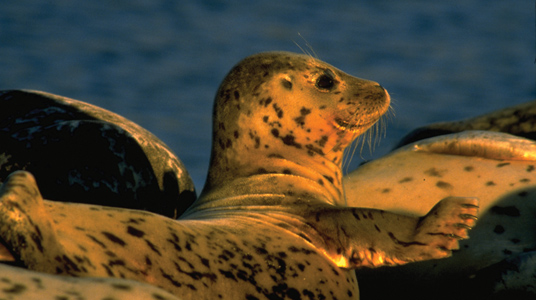Pupping season is a time to be especially aware of your marine environment, because inadvertent human interference can literally be fatal to harbor seals. By learning more about the process, we can respect and protect these precious creatures.
Photo courtesy of Farallones Sanctuary/Jamie Hall
By Mary Jane Schramm
Published: March, 2009
Pupping season is a time to be especially aware of your marine environment, because inadvertent human interference can literally be fatal to harbor seals. By learning more about the process, we can respect and protect these precious creatures.
The following scenario plays out over and over again all over the Bay Area: A female harbor seal restlessly swings her hindquarters, while a few interested gulls dance on the wet sand nearby. Without much more activity, quickly, smoothly, the female seal gives one last push, and a small head emerges. The pup slides into the world, heralded by the clamoring gulls. Calling softly to one another, the female and her pup soon begin to recognize each other’s voices, and a bond forms. The pup nuzzles its mother and begins to nurse.
Ferry riders, boaters and beach-goers can encounter mother seals and pups almost anywhere in the region. Within San Francisco Bay, colonies exist at Alcatraz Island, Mowry Slough, Castro Rocks, Yerba Buena Island, and Newark Slough. Outer-coast colonies to the south include Point San Pedro, Fitzgerald Marine Reserve, Pescadero, Pebble Beach, and Bean Hollow. To the north, Bolinas Lagoon, Tomales Bay, Drake’s Bay and Jenner are important seal rookeries.
In the San Francisco Bay Area, with its human population of nearly eight million, the interface between seal and human habitats creates complex problems. Causes of seal disturbance include hikers, birders, dogs, aircraft, and vessels such as motorboats and kayaks. Although some wildlife experts recommend keeping 300 feet away from any seal pups, even at that distance disturbance can occur. The rule of thumb is, if a seal reacts to your presence, you’re too close, said sanctuary marine biologist Jan Roletto. Avoid eye contact and back away slowly until they no longer notice you.
Tragically, each year healthy harbor seal pups are separated from their mothers by people who mistake them for orphans. Harbor seal mothers normally leave their pups unattended on beaches while feeding at sea. They will later rejoin and nurse them. The presence of humans or dogs near a seal pup could prevent its mother from reuniting with her young one, and result in the pup’s death.
Even whole colonies are vulnerable; while harbor seals may voluntarily approach divers in the water, on shore they become restless and may stampede, or flush, into the water if disturbed. If this happens repeatedly, it could result in overall lower birth rates, reduced habitat use and eventual abandonment of seals’ haul-out sites.
NOAA’s Gulf of the Farallones National Marine Sanctuary, which protects outer coast waters beyond the Golden Gate, advises Bay Area beachgoers against interacting with any seal pups they may find on the beach. The sanctuary advises concerned beachgoers to report suspected orphaned or injured pups to a park ranger, or to a licensed facility to assess the need for rescue. The relevant contact numbers are: the Marine Mammal Center, (415) 289-SEAL, or the Pt. Reyes National Seashore, (415) 464-5170. Furthermore, it should be noted that seals are federally protected under the Marine Mammal Protection Act, and to interfere with one could incur legal penalties.
Harbor seals have an almost feline appearance: rounded head, flat muzzle, long whiskers, and large dark eyes. They’re comparatively small—only about 250 pounds, with an average length of 5 feet. Like all true seals, they lack external ears, and cannot rotate their hind flippers around to move on land; instead, they inchworm their way across the sand, blubber quivering. Their color can range from nearly all white with a few dark markings to nearly all black with white markings.
They can often be seen draped over offshore rocks like shiny wet slugs, or scattered like flung driftwood across gently sloping beaches and mudflats. Harbor seals can migrate several hundred miles from breeding colonies, and may commute between offshore waters up inlets and freshwater rivers in search of prey such as fish and squid.
Females generally give birth to a single pup. Pups can swim at birth, and may piggyback on their mothers’ backs to rest between mother’s foraging bouts. The pup remains with its mother and nurses for approximately four weeks, almost doubling its birth weight. By then, the pup—replete with its mother’s fat-rich milk—has developed a thick blubber layer to carry it through its predator apprenticeship to become a proficient hunter.
Beyond contributing to the pup’s genes, the male occupies his time during breeding season with in-the-water combat with other males, competing for the females’ attention. Monogamy is not in their vocabulary.
To best enjoy harbor seals, arm yourself with binoculars or a spotting scope, and enjoy them from a distance. You’ll be rewarded with the chance to observe natural seal behaviors—even if they are only sleeping. For additional information on sanctuary wildlife, programs and issues, visit the sanctuary and sanctuary association’s websites at farallones.noaa.gov and farallones.org, or call (415) 561-6625.

Photo courtesy of Farallones Sanctuary/Jamie Hall

